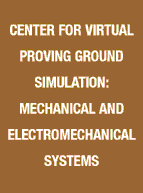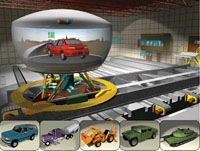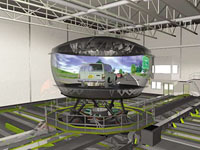
| Table of Contents | |
| Overview | |
| About NSF | |
| Advanced Electronics | |
| Advanced Manufacturing | |
| Advanced Materials | |
| Biotechnology | |
| Civil Infrastructure Systems | |
| Information and Communication | |
| Energy and Environment | |
| Fabrication & Processing Technology | |
| Health and Safety | |
| Quality, Reliability & Maintenance | |
| System Design and Simulation | |
|
Center for Virtual Proving Ground Simulation: Mechanical and Electromechanical Systems |
|

Center for Virtual Proving Ground Simulation: Mechanical and Electromechanical Systems
The University of Iowa (lead institution) and the University of Texas at Austin
A National Science Foundation Industry/University Cooperative Research Center since 1997
Engineering-fidelity virtual proving ground simulation offers a revolutionary new approach to developing vehicle and equipment designs for improved performance and safety

|
Center Mission and Rationale
The Center is building upon the unique capabilities of (1) the National Advanced Driving Simulator (NADS) the U.S. Department of Transportation has constructed at the University of Iowa and (2) the Center for Electromechanics at the University of Texas at Austin. The Center's mission is to create virtual proving grounds with U.S. industry that will enable fundamental advances in vehicle and equipment product development effectiveness. Results of advanced vehicle engineering research are transferred to the U.S. industry and federal organizations that jointly sponsor Center research. A number of agricultural, construction, and defense vehicle manufacturers are members of the Center, supporting focused research on off-road vehicle and equipment operator-in-the-loop virtual proving ground experimentation.
Research Program
The Center's basic technical objectives are to develop the following:
- Vehicle and Equipment Modeling and Simulation Tools -- Modeling and simulation technology under development will enable operator-in-the-loop simulation experiments to be conducted on the NADS at a design level of fidelity. Accurate physics-based representations of vehicle subsystems are developed and integrated in core simulation software to provide a rich environment for conducting human-machine interaction performance evaluation and system and component engineering design studies, through parametric iterations.
- Virtual Proving Ground Modeling Methods -- The Center is establishing techniques for modeling terrain in support of advanced operator-in-the-loop simulation, with a focus on automatic correlation of terrain, visual, and road databases, along with the ability to support dynamically changing terrain on any part of the database. The architecture supports distributed execution of the terrain model and automatic dynamic correlation between multiple simulators. New methods for the rapid development of correlated databases are being developed, based on the concept of tile authoring.
- Networked Simulations for Virtual Proving Ground Applications -- Tools and algorithms are being refined to support distributed collaborative execution of multiple high-fidelity simulators across high-speed networks. The goal is to help engineers actively participate in engineering design by interactively varying design parameters while a human operator is exercising equipment. The concept of "engineer tele-presence" will provide unique capabilities to manufacturers that can benefit from high-fidelity simulations in synthetic environments. Furthermore, geographically distributed sites can seamlessly interchange data through the network, and custom tools can process real-time data, enabling interactive parameter optimization under realistic operating conditions.
- Real-Time Dynamic System Simulation Methods -- Physics-based representations of vehicle chassis and subsystems are being formulated and integrated in the vehicle system dynamic equations of motion. These equations are efficiently solved using advanced numerical techniques that include differential-algebraic equation solvers and single- and dual-rate integration algorithms, accounting for the effects of discontinuities. The potential for using parallel computation to enhance performance is receiving the most attention, with application to both supercomputing facilities and distributed-network implementation.
- Tire/Track-Soil Interaction Models -- Research in tire/track-soil interaction modeling is being conducted in order to understand how vehicles interact with different terrains. Soil deformation due to vehicle-induced forces is computed using soil mechanics theory. The resulting deformation is reported back to the visual environment, which in turn displays the deformation in real time. Due to the complexity of this computation, finite-element models are used to generate parametric models for real-time applications. This capability represents a virtual tire-soil testing facility that generates real-time model-specific parameters for different commercial tire types.
- Electromechanical System Modeling and Simulation Methods -- A comprehensive library for electric drive-train simulation is being created for next generation on- and off-road vehicles. A joint university study funded by the Defense Advanced Research Projects Agency (DARPA) has implemented and validated simulation-based design procedures for proposed electric vehicle designs. Modeling tools for AC and DC electric generators linked to diesel or gasoline engines are used to power electric motors in a number of vehicle configurations. Models for energy storage devices -- such as batteries, ultracapacitors, and flywheels -- are being developed to provide a rich set of options during the early stages of design. Research in fuel cell technology contributes to fuel cell model development.

|
The Center believes that performing pilot research projects with its members is the most effective means of focusing on key problems that must be solved to create a virtual prototyping capability that meets industry and government needs. Since its inception, the Center has carried out pilot projects related to military and commercial vehicles and construction equipment. These pilot projects have been augmented by major research projects sponsored by DARPA and the Army's Tank-Automotive Research Development and Engineering Center (TARDEC). Typical pilot projects undertaken by the center are:

|
- Physical Simulation Laboratory Upgrade -- A $750,000 initiative sponsored by TARDEC at Iowa is developing core dynamics software and visual and terrain database construction and interrogation tools for TARDEC's Ride Motion Simulator and Turret Motion Base Simulator. A vehicle modeling and real-time simulation environment is being developed and implemented in TARDEC's simulator laboratory to enable vehicle and equipment virtual prototyping experiments needed for Simulation Based Acquisition of future military vehicle systems.
- Automotive Research Center (ARC) -- A $400,000 per year project at Iowa, sponsored by TARDEC's National Automotive Center with the University of Michigan, is contributing fundamental engineering research on synthetic environments and modeling and simulation for virtual proving ground simulation. The main focus is to refine advanced computational methods and visualization techniques to enable real-time operator-in-the-loop experiments.
- Vehicle and Equipment Virtual Proving Grounds -- A $2 million-dollar dual-use joint project with TARDEC's National Automotive Center, DARPA, John Deere, and the State of Iowa is developing enhanced vehicle and equipment simulation and visualization tools, networking and communication protocols, and command and control stations for distributed collaborative experiments. This technology is essential in order to collect and evaluate complex engineering and human performance data in real time, among different simulator sites, during collaborative experiments. With John Deere's participation, an agricultural proving ground is being developed and will be used to demonstrate these collaborative environments.
- Electric Machine Characterization -- A suite of computer-based measurement tools has been developed by researchers at Texas to measure machine parameters, as part of an electric-drive simulation project with DARPA. Continuing efforts are examining powertrain trade-off studies for off-road vehicles, contrasting conventional and electric drives. Development of electromechanical active-suspension systems has evolved to full-vehicle implementation on the military vehicle shown, involving control system design, development, and testing.
Center Headquarters
Center for Virtual Proving Ground Simulation: Mechanical and Electromechanical Systems
2401 Oakdale Boulevard
The University of Iowa
Iowa City, IA 52242
Tel (319) 335-5726*Fax (319) 335-4658
Homepage: wash.nads-sc.uiowa.edu/
Center Director: Dr. Edward J. Haug
haug@nads-sc.uiowa.edu
Iowa Site Director: Dr. L. D. Chen
(319) 335-4851 * ldchen@icaen.uiowa.edu
Texas Site Director: Dr. Raul G. Longoria
(512) 471 0530 * r.longoria@mail.utexas.edu
Center Evaluator: Dr. Arthur H. Miller
(319) 335-2347 * arthur-miller@uiowa.edu
NSF 01-168yy